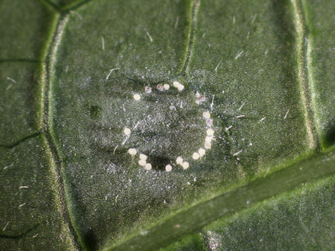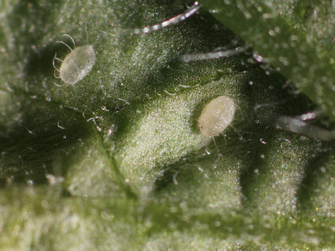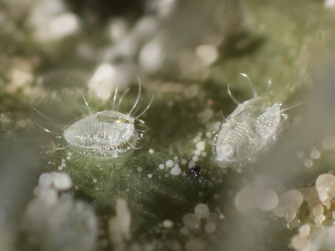Greenhouse whitefly
Trialeurodes vaporariorum
Profile
The greenhouse moth scale insect, also called whitefly, originates from East Africa and is found in Austria on numerous greenhouse crops. Its name comes from the fact that the larvae are stuck similar to scale insects, while the adult insects are able to fly like small white moths. In addition to sucking damage, visual impairment of the plants occurs due to honeydew excretion.
Appearance

The adults, about 2 mm in size, have two pairs of wings and are covered with fine white wax dust. They usually sit well protected on leaf undersides and jump away by means of their hind legs when disturbed, after which a flight begins.
The larvae develop through four scale-like stages, growing to about 0.8 mm in length. The first larval stage is still freely mobile with functional extremities, but these later atrophy. All stages are predominantly transparent and show paired yellow spots inside the body. The last developmental stage (pseudopuparium) looks like a tiny oval-shaped box with vertical walls and is white to yellowish in color.
The 0.25 mm long spindle-shaped eggs are anchored to the undersides of younger leaves with a small stalk in the leaf, through which they are supplied with moisture. Freshly laid, they are white, but become progressively darker during their development, which lasts about six to eight days (at 20 °C).
Biology
The greenhouse moth scale insect belongs to the moth scale insects (Aleurodina) a subgroup of plant suckers.
The greenhouse moth scale insect goes through several stages of development until it becomes an imago.
The larvae in the first stage look for a place on the natal leaf to suck plant sap, which they later do not leave. From the second larval stage on, the animals are attached to the plants. Using a sucking proboscis (similar to aphids), they extract sugar sap from the vascular bundles of their host plant. In many host plants with tiers of leaves, such as cucumbers or tomatoes, the egg-laying females are found on the upper, younger leaves; the larvae are found on the middle leaves, while the hatching whiteflies are found on the lower, older leaves.
Eggs, as well as larvae and adults, constantly require fresh plants for survival and perish on wilted leaves after a short time. Symbiotic microorganisms (bacteria) that produce vitamins important to the moth scale insect live in the yellow spots inside the body. During egg development, the bacteria migrate from the mother animal into the still unfinished eggs and are transferred in this way to the animals of the next generation.
At 21 °C, development from egg to finished insect takes 25 to 30 days. Thus, numerous, overlapping generations can develop in any given year.
In our country, the whitefly can only overwinter on green plants in glass houses or living rooms, as it has no dormant stage and is also sensitive to cold.
Damage symptoms
Infested plants are usually damaged less by the direct sucking activity than by sugary excretions (honeydew) of the larvae. Since the animals prefer to sit on the undersides of leaves, the honeydew drips onto the leaves and fruit below. Black fungi can then colonize this shiny coating. This so-called "sooty mold" contaminates the fruit on the one hand, and on the other hand, affected leaves lose assimilation surface, which weakens the plants.
Economic importance
The greenhouse moth scale has become an economically important pest of greenhouse vegetables and ornamentals because, in addition to direct sucking damage, it damages plants indirectly as a virus vector and it has already developed resistance to insecticides, making it difficult to control.
Prevention and control
- Prevention of overwintering: particular danger comes from overwintering ornamental plants (hanging baskets in front rooms or in neighboring homes). Fuchsias, gerberas, etc. are often particularly heavily infested.
- Avoidance of spreading: never go from a heavily infested greenhouse to an uninfested one.
- Monitoring: in order to detect the initially harmless infestation by the moth scale insect in time, glued yellow boards should be fixed just above the plant tips. The yellow color attracts numerous pest species, such as whitefly, fungus gnat, and leaf miner. However, yellow panels alone are not suitable for effectively controlling whiteflies.
- Chemical control: Sprays against whitefly(s) (moth scale insects) or sucking insects can be used as chemical control. At least two treatments are necessary, about five to seven days apart. The whitefly tends to develop resistance to pesticide active ingredients - this forces frequent changes of active ingredient groups (see list of pesticides approved in Austria).
- Biological control: By releasing Encarsia wasps: this small wasp injects its eggs into young whitefly larvae, so that the last to hatch is a whitefly instead of a whitefly. In individual cases, additional selective plant protection products that are gentle on beneficial insects may have to be applied. If beneficial insects are used, the lower leaves should not be removed too quickly, as this often results in the removal of wasps that have not yet hatched. Furthermore, yellow panels should not be used, as the wasps are also caught by the yellow panels.
- Other beneficial insects that can be used are the ichneumon wasp Eretmocerus eremicus and the predatory bug Macrolophus caliginosus, which can be combined well with Encarsia. Predatory mites of the genus Amblyseius and entomopathogenic fungi(Beauveria bassiana) can also be used to reduce infestations against whiteflies.
Last updated: 18.01.2022
automatically translated



